The 'Ama-ZING' Teacher
A day in the life story
Amy Renner Hendricks | Marketing & Communications
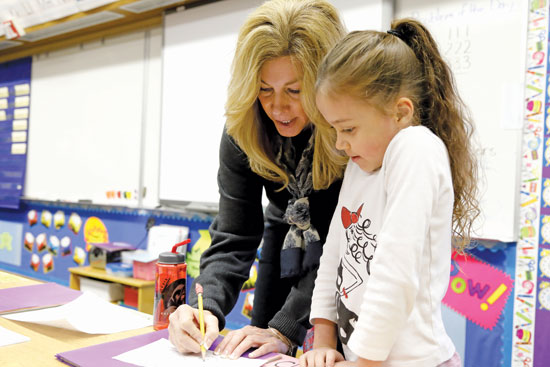
“Everything hurts, and I’m dying.”
That’s what I told my husband after spending all day in Heather Hales’ second-grade classroom at H. Guy Child Elementary in South Ogden. I said it jokingly, just to see if my husband would catch the Parks & Recreation television show reference, but two Advil and a nap later, my head, neck, shoulders, legs and feet still ached — a horrible, deep pain. “I was dying earlier today, and then I died. Now I’m dead,” I told my own second-grader. She ignored me, giving me that look that said, “Jeez, Mom, you’re quoting Parks & Rec again.”
Teaching is serious business. And teachers are superheroes. Literally. You have to be to do what they do. Here’s what my exhausting, but fun, day in second grade looked like.
7:45 a.m. I arrive. Mrs. Hales has been here since 7 a.m., an hour and 40 minutes before school starts. She is quick to note this is not a requirement. “You definitely don’t have to get here this early to be a good teacher,” she emphasizes. “When my own kids were little, I didn’t get here this early. They’re grown now, so this is just the routine I like.”
7:50 a.m. Mrs. Hales dashes off to a meeting. H. Guy Child is one of 45 schools participating in a state initiative called Assessment to Achievement, which focuses on effectively using data to improve student achievement. Mrs. Hales, along with eight other teachers and the school principal, make up a leadership team that meets weekly. They discuss ways to help improve the grade-level professional learning community (PLC) process to increase student learning. They talk about evidence-based teaching methods to improve student academic success and raise test scores. “Testing is a reality,” Mrs. Hales acknowledges. “We have state tests, but I think it’s hard to have one moment — one test on one day — to show how a student is doing. In the classroom, I like to give quick assessments frequently, so I know exactly where my students are and can respond with the support they need to further their learning progress.”
8:30 a.m. The meeting ends. Mrs. Hales heads back to class.
8:35 a.m. The first bell rings. Mrs. Hales steps outside. All of the second-graders are lined up. She leads them in a lively chant:
“Second-graders, get tall and straight.
Second grade is really great.
We’re here to learn and do our best.
We’ll help each other with friendly zest.
There’s much to do; it’s time to begin.
Get focused and ready; it’s time to go in.”
As the students file by, they hang up their winter gear in the hallway, with the exception of one little boy. “It’s a brand-new coat,” Mrs. Hales explains to me, smiling. “He likes to keep it on.” She tells the students, “Show me you know right what to do.” They know to correct their journal entries from the day before. Problem areas are underlined in purple. “I like the way Natilee got to work,” Mrs. Hales praises.
8:40 a.m. A line of students has formed at Mrs. Hales’ desk. She encourages them to tell her why certain items are underlined. “I didn’t put a date. I need to capitalize that,” students say. Some of the mistakes aren’t as easy. “The word ‘sincerely’ needs to be written full size. Fix those commas,” Mrs. Hales instructs.
8:45 a.m. Mrs. Hales goes to the whiteboard. “Ohayo gozaimasu,” she says. “Ohayo gozaimasu,” the students say in unison. “For our guests in the room, that means good morning in Japanese,” Mrs. Hales explains. “Now, I’m going to check the time. This one is tricky. Can someone tell me what time it is?” Aspen raises her hand. After a long pause, she answers 8:45. “Yes!” Mrs. Hales says. “That was hard! I’m so proud of you! Did you notice how quiet our class was while giving Aspen thinking time? That’s how you support her learning!” (That’s an important theme in Mrs. Hales’ class.)
8:47 a.m. Mrs. Hales sits down briefly at her desk to take attendance while kids quietly continue working on math problems and the day’s journal entries (the new journal entry is about a colorful bird that has been posted on an art easel). Two students come to ask questions: “Can I go to the bathroom?” and, “What kind of a bird is that?” Mrs. Hales rapid-fire answers: “Yes.” And, “Now, what do we do if we don’t know what that bird is? We can look in a reference book. Right now, it’s a mystery.”
8:58 a.m. Mrs. Hales tells the children they have two more minutes for journal time. “How do you spell cockatoo?” a little boy asks. “Oh, you’re asking a question I need a dictionary to answer!” she answers. “OK. It’s spelled a really fun way. C-O-C-K-A-T-O-O.”
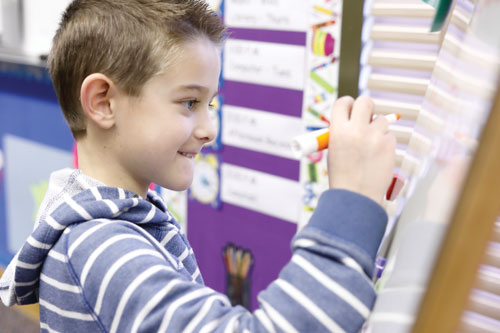
9 a.m. Logan leads calendar time, reciting the date, time and season. He predicts the next shape for their pattern. “I think it’s a cube,” he says. “He’s right,” Mrs. Hales announces. “Give him a quiet thumbs up.” Then he reads one of the learning goals for the week.
9:05 a.m. Logan leads the Pledge of Allegiance.
9:06 a.m. The students trade math worksheets and correct each other’s work. Mrs. Hales goes over the answers in detail on her projector. She walks through the rows to describe how the children solved the problems differently. “Madilynn drew 16 circles and crossed out nine to get the answer. Lainey drew dots and counted how many there were between nine and 16. These are smart, smart strategies. I love it!” she says.
9:15 a.m. The students pass the papers back to the owners, and a line forms in front of Mrs. Hales. One student wants to know why his clock was marked incorrectly. “What am I concerned about here? I really like that short hand, but the long hand needs to go all the way up to the 12,” she explains.
9:20 a.m. They transition to sight words. “Let’s all read them together,” Mrs. Hales says. “Get ready. Read.” They are out of sync and speaking very quickly. “Uh-uh!” She stops them. “Let’s start again, and go a little slower.”
9:25 a.m. The class sings a song about contractions. “A contraction has an apostrophe that takes the place of letters, you see,” they belt out together.
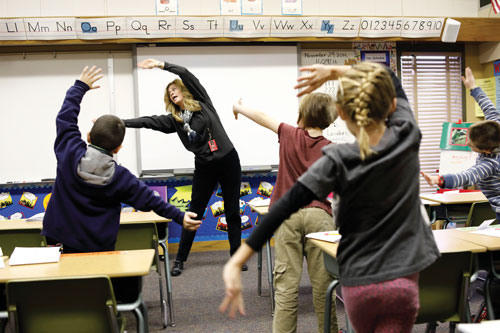
9:27 a.m. Mrs. Hales leads the students in fun physical exercises. They do arm circles, counting by 2s, 5s and 10s. They do windmills, counting by 100s. They do football runs, counting by 10,000s.
9:30 a.m. They take a bathroom and drink break.
9:34 a.m. Metacognition superhero time! “Metacognition is a big word,” Mrs. Hales says, doing a superhero pose. “Remember, it means thinking about your thinking. We work to learn. It gets harder. We work to learn more! Metacognition!”
9:35 a.m. Mrs. Hales shows the students a video of a kindergartener assessing her work. “What does assess mean? It means she’s looking at how she’s doing,” she explains.
“Now, look at this journal entry from a second-grader and tell me what we should be concerned about,” Mrs. Hales instructs. The students list what is wrong. They do this for five more examples. She then instructs the students to assess their own journals. After a few minutes, she says, “Freeze! Who has power over their own learning? You do! You can find mistakes and fix them. You can be successful!”
10 a.m. The students move to the reading alcove, where they all read It Won’t Be Easy together aloud. They look for letter combinations that make the long ‘e’ sound. She stops mid-sentence. “Here’s a contraction! It’s a sneaky one! Raise your hand if you can tell me what ‘won’t’ means!” A student answers, “Will not.” “Yes!” and they start to read again.
10:12 a.m. “OK. If your journal is done, you may now go to recess,” Mrs. Hales says.
10:15 a.m. Recess. Are you exhausted yet? I am.
10:30 a.m. The children file back into the classroom. A little boy searches out Mrs. Hales to tell her about an incident on the playground. Two other children say they saw what happened. She asks all of the children involved how the incident made them feel. They apologize and are over it quickly.
10:36 a.m. They read phonics fluency poems I Can Feel the Beat and Peas. The peas poem gets a few “Ewwwws!” It starts like this: “I like peas covered with cheese …” “Don’t say ew!” Mrs. Hales says. “Some people may like their peas covered with cheese.” But then it says, “I like peas in ice cream freeze,” and Mrs. Hales says, “OK, you can make a face like this (a grossed-out face), but don’t make a sound while you’re doing it!”
10:40 a.m. “OK, class, we’re cleaning up our supplies now and are going to practice these poems with a partner,” Mrs. Hales announces. “Try to practice with someone new!” The kids gather in groups of three to say and act out the poems.
10:50 a.m. The groups present their poems.
11 a.m. Students from a different second-grade class rotate in; one group sits in a circle with Mrs. Hales, another with a volunteer. They take turns reading one line each from a book. “Freeze!” Mrs. Hales says. “Do you see that word that is slanted? That’s called italics. It means we emphasize that word,” she explains. A few minutes later, a student comes across another italicized word and reads it without emphasis, stops and reads it again correctly. “Ooh, I like the way you self-corrected,” Mrs. Hales says, and the student smiles.
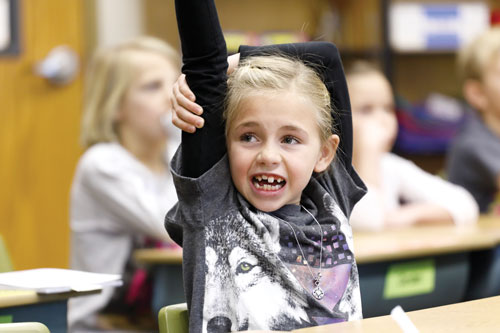
11:30 a.m. The students finish reading and transition back to their classes. Mrs. Hales’ students complete their planners, writing what they did that morning. “Read 20 minutes. Had special WSU visitors!” they write. “Or, we could call them guests,” a student says. “Or company!” another student suggests. Mrs. Hales stops, smiles and says, “Yes! Good synonyms!”
11:35 a.m. The students line up to go to the cafeteria and sing:
“We’ve washed our hands.
We have our lunch and card and Mrs. Hales’ card.
And now we’re ready to munch on lunch.
Muncha, muncha, muncha, let’s go to lunch!”
And off they go, with Cohen leading the line and Mrs. Hales following behind. Once they’re settled in the cafeteria, she goes back to the classroom, stopping by a first-grade class to give the teacher a handful of Pokémon cards. “We’ve had a little problem with Pokémon cards this week,” she explains.
11:45 a.m.-noon Mrs. Hales eats quickly, then sorts magnifying glasses and penny stamps for her afternoon lesson.
12:15: p.m. The children arrive back to the classroom and sing:
“We munched on our lunch, and we played for a bit.
We’ll be ready for more learning in a lickety-split!”
12:20 p.m. They gather at the alcove to read Flat Stanley. Stanley gets made fun of, and Mrs. Hales looks at her class and asks, “Do we make fun of people?” “No!” they shout.
12:33 p.m. “The end,” Mrs. Hales says, closing Flat Stanley.
12:35 p.m. “It’s time to do Calendar Math,” Mrs. Hales says. “Get your white boards. You may doodle on them if you’re quick.” They spend the next 20 minutes working on place value (hundreds, tens and ones). One student gives the others a way to remember place value. “Think HTO (hundreds, tens, ones) in your mind,” she says. “Yes!” Mrs. Hales praises. “That’s a great idea!” They also work on shapes, including quadrilaterals.
1 p.m. They line up to go to computer. On the way, Mrs. Hales stops to help two students tie their shoes. On the way back to her classroom, she goes on a search for white paper. Locating that, she gets back to her own computer and finds a video on YouTube about the penny.
1:30 p.m. Mrs. Hales gets her students from computer.
1:35 p.m. The last students present their phonics poems.
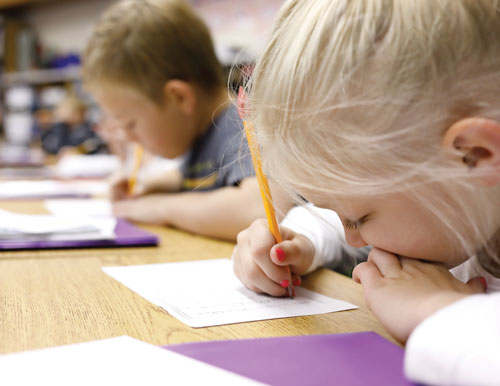
1:43 p.m. Students take a practice math test. “Do your best. Do not get discouraged. We are practicing,” Mrs. Hales reminds them, as she walks up and down the rows of students, many of whom are concentrating so hard their tongues are stuck out.
1:50 p.m. Mrs. Hales plays the video about pennies.
1:55 p.m. Students use magnifying glasses to investigate the words and pictures on pennies, and Mrs. Hales lists what they find on the projector. “The second ‘l’ in Lincoln is silent,” one student observes. “Yes, Carden, it is!” Mrs. Hales says. “What do we say?” “Carden, you’re ama-ZING!” they answer.
2:15 p.m. Recess.
2:35 p.m. I give a small presentation about Weber State University, tell them what my job is and pass out WSU color-changing pencils.
2:55 p.m. The students work on their pop-up coloring books of the Liberty Bell and Statue of Liberty as part of a social studies lesson. Groups of two are sent to a table where they put penny stamps and stickers on their money worksheets.
3:05 p.m. The students do their classroom jobs, check their cubbies and straighten up their desks. A picture falls off the white board, and Ridge takes a quick break from his job to pick it up. “Hey!” another student says, “we should give him a Charger cheer!” So they do.
3:15 p.m. The first bell rings, and students line up. Children, in groups of two, say announcements, broadcasting who they thought had the most organized desks, who solved the problem of the day, etc. They sing a song about what they did:
“Goodbye, everybody, goodbye.
Goodbye, everybody, goodbye.
We saw her (pointing at me).
And we went to computers!
And we had a good day!
Ja mata everybody, ja mata (see you later in Japanese)!
3:20 p.m. The bell rings to go home. Mrs. Hales escorts her children to the pickup line. She has bus duty. She spends 10 minutes in the cold, ensuring children get on the right bus and into the right cars. She rescues one from atop a snowy hill.
3:30 p.m. Mrs. Hales leaves for the day but only because she has an appointment. She brings work home to prep for tomorrow.
3:31 p.m. I leave, exhausted and cold, but holding an ama-ZING thank you note from a student. It reads:
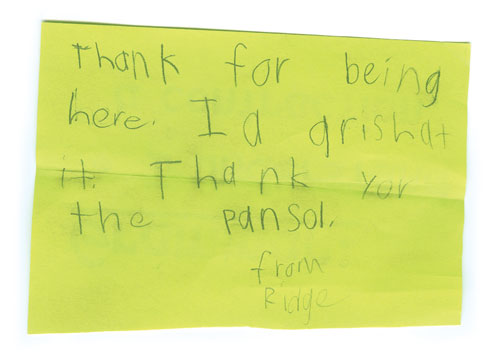
Translation: “Thank you for being here. I appreciate it. Thank you for the pencil.” He asked me multiple times if I was going to keep his note. It’s hanging in my office. It makes me smile every day and makes me understand why teachers do their very tiring, but rewarding, jobs.
Heather Hales received her bachelor’s degree in English from Weber State University in 1991. She earned her master’s degree in education from WSU in 2006 and has been a teacher for 16 years. She is the president of the WSU Alumni Association Board of Directors. She wants to thank all of the fabulous parent and grandparent volunteers who help in her class. “They are fantastic,” she says. Or, as her class would say, “They’re ama-ZING!”
